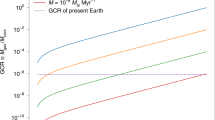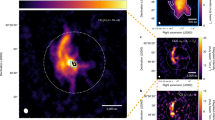Abstract
The formation of low-mass stars like our Sun can be explained by the gravitational collapse of a molecular cloud fragment into a protostellar core and the subsequent accretion of gas and dust from the surrounding interstellar medium1,2,3. Theoretical considerations suggest that the radiation pressure from the protostar on the in-falling material may prevent the formation of stars above ten solar masses through this mechanism4, although some calculations have claimed that stars up to 40 solar masses can in principle be formed via accretion through a disk5,6,7. Given this uncertainty and the fact that most massive stars are born in dense clusters, it was suggested that high-mass stars are the result of the runaway merging of intermediate-mass stars8. Here we report observations that clearly show a massive star being born from a large rotating accretion disk. The protostar has already assembled about 20 solar masses, and the accretion process is still going on. The gas reservoir of the circumstellar disk contains at least 100 solar masses of additional gas, providing sufficient fuel for substantial further growth of the forming star.
This is a preview of subscription content, access via your institution
Access options
Subscribe to this journal
Receive 51 print issues and online access
$199.00 per year
only $3.90 per issue
Buy this article
- Purchase on Springer Link
- Instant access to full article PDF
Prices may be subject to local taxes which are calculated during checkout





Similar content being viewed by others
References
Larson, R. The emitted spectrum of a protostar. Mon. Not. R. Astron. Soc. 145, 297–308 (1969)
Shu, F., Adams, F. & Lizano, S. Star formation in molecular clouds—Observation and theory. Annu. Rev. Astron. Astrophys. 25, 23–81 (1987)
Larson, R. in Galactic Star Formation Across the Stellar Mass Spectrum (eds De Buizer, J. M. & van der Bliek, N. S.) ASP Conf. Ser. Vol. 287, 65–80 (Astronomical Society of the Pacific, San Francisco, 2003)
Wolfire, M. & Cassinelli, J. Conditions for the formation of massive stars. Astrophys. J. 319, 850–867 (1987)
Nakano, T., Hasegawa, T. & Norman, C. The mass of the star formed in a cloud core: Theory and its application to the Orion A cloud. Astrophys. J. 450, 183–195 (1995)
Jijina, J. & Adams, F. Infall collapse solutions in the inner limit: Radiation pressure and its effects on star formation. Astrophys. J. 462, 874–887 (1996)
Yorke, H. & Sonnhalter, C. The formation of massive stars. Astrophys. J. 569, 846–862 (2002)
Bonnell, I., Bate, M. & Zinnecker, H. On the formation of massive stars. Mon. Not. R. Astron. Soc. 298, 93–102 (1998)
Chini, R. & Wargau, W. Young stellar objects and abnormal extinction within M 17. Astron. Astrophys. 329, 161–168 (1998)
Hanson, M. & Conti, P. The young massive stellar objects of M 17. Astrophys. J. 489, 698–718 (1997)
Greenhill, L., Gwinn, C., Schwartz, C., Moran, J. & Diamond, P. Coexisting conical bipolar and equatorial outflows from a high-mass protostar. Nature 396, 650–653 (1998)
Marti, J., Rodriguez, L. & Reipurth, B. HH 80–81: A highly collimated Herbig-Haro complex powered by a massive young star. Astrophys. J. 416, 208–217 (1993)
Hofner, P., Wiesemeyer, H. & Henning, T. A high-velocity molecular outflow from the G9.62 + 0.19 star-forming region. Astrophys. J. 549, 425–432 (2001)
Gehrz, R. et al. Anatomy of a region of star formation—Infrared images of S106 /AFGL 2584. Astrophys. J. 254, 550–561 (1982)
Shepherd, D., Claussen, M. & Kurtz, S. Evidence for a solar system-size accretion disk around the massive protostar G192.16–3.82. Science 292, 1513–1518 (2001)
Sandell, G., Wright, M. & Forster, J. NGC 7538S—a high-mass protostar with a massive rotating disk. Astrophys. J. 590, L45–L48 (2003)
Muzerolle, J., Calvet, N. & Hartmann, L. Emission-line diagnostics of T Tauri magnetospheric accretion. II. Improved model tests and insights into accretion physics. Astrophys. J. 550, 944–961 (2001)
Muzerolle, J., Hartmann, L. & Calvet, N. Emission-line diagnostics of T Tauri magnetospheric accretion. I. Line profile observations. Astron. J. 116, 455–468 (1998)
Hamann, F. & Persson, S. Emission-line studies of young stars. II. The Herbig Ae/Be stars. Astrophys. J. Suppl. 82, 285–309 (1992)
Hartigan, P., Edwards, S. & Ghandour, L. Disk accretion and mass loss from young stars. Astrophys. J. 452, 736–768 (1995)
Calvet, N. Properties of the winds of T Tauri stars. IAU Symp. 182, 417–432 (1997)
Hartmann, L., Hewett, R. & Calvet, N. Magnetospheric accretion models for T Tauri stars. I. Balmer line profiles without rotation. Astrophys. J. 426, 669–687 (1994)
Siebenmorgen, R. & Krügel, E. The protostellar system HH108MMS. Astron. Astrophys. 364, 625–632 (2000)
Acknowledgements
We thank the directors of ESO and IRAM for the allocation of discretionary time to perform the adaptive optics image and the molecular line observations, respectively. We also thank the Paranal Science Operations team for performing the infrared observations in service mode. This work was supported by the Nordrhein-Westfälische Akademie der Wissenschaften, funded by the Federal State Nordrhein-Westfalen and the Federal Republic of Germany.
Author information
Authors and Affiliations
Corresponding author
Ethics declarations
Competing interests
The authors declare that they have no competing financial interests.
Rights and permissions
About this article
Cite this article
Chini, R., Hoffmeister, V., Kimeswenger, S. et al. The formation of a massive protostar through the disk accretion of gas. Nature 429, 155–157 (2004). https://doi.org/10.1038/nature02507
Received:
Accepted:
Issue Date:
DOI: https://doi.org/10.1038/nature02507
This article is cited by
-
A two-dimensional study for cooling and self-gravitating accretion discs
Astrophysics and Space Science (2014)
-
The critical role of disks in the formation of high-mass stars
Nature (2006)
-
Infall of gas as the formation mechanism of stars up to 20 times more massive than the Sun
Nature (2006)
Comments
By submitting a comment you agree to abide by our Terms and Community Guidelines. If you find something abusive or that does not comply with our terms or guidelines please flag it as inappropriate.



